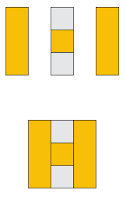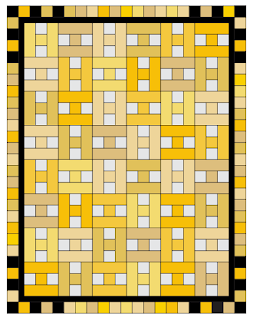Most of you already know that although I now live in Florida, I'm a Pittsburgh girl at heart. Today, July 19th 2020 I'm celebrating the 109th anniversary of the Pittsburgh "H". Way, way, way back when the city was named, "Pittsburgh" was chosen to honor William Pitt. However, the actual selection of the name was made by a Scotsman, General Forbes. To his way of thinking it made sense to add the "h" to the end, as in Edinburgh.
The story doesn't end there. In 1891, due to a paperwork snafus' official documents were recorded without the "h" at the end and Pittsburgh became Pittsburg. From 1891 until 1911 the US government spelled the cities name one way and the city government spelled it another. Finally 109 years ago on July 19th 1911 the US Geographic Board voted to reinstate the "h" and Pittsburgh got it's "h" back. Let's party!
For this project you are going to need:
24 strips 2 1/2" by the width of the fabric, you can cut these yourself or use part of a jelly roll.
1/2 yard of background fabric or 6 strips 2 1/2".
3/4 yard of fabric for the inner border and binding.
2 1/4 yards of border fabric if you want a larger quilt."
Begin by cutting all 24 of your strips into the segments shown below. Keep the strips folded. Working from left to right, remove the selvedge edge. Cut 2 segments 6 1/2" long. Cut the remainder of the strip into 2 1/2" squares. Normally I would never ask you to cut across the fold, but for this project if you get just one more square from the strip you will have exactly what you need for the project. If your strips were cut wonky, you might need to grab some fabric from your stash to make up the extra blocks for the pieced border.
Now cut the 6 strips of background fabric into 96 background squares measuring 2 1/2". There are 48 blocks in this quilt and you are going to need 2 background squares for each block.
Each H block has 2 rectangles and 1 square cut from the same fabric. By following the cutting diagram above you will be making 2 identical blocks from each strip. The remaining 2 1/2" squares make the pieced border, set these aside. Select 2 squares from each strip and stitch a background square to opposite sides. Use a 1/4" seam allowance. Don't make the mistake of sewing a background square to ALL of the 2 1/2" squares.
Now sew a 2 1/2" by 6 1/2" rectangle to each side of your pieced unit. One H block complete! Press the seams toward the darker fabric in the center section and toward the rectangles on the outer edge. These blocks will measure 6 1/2" including seam allowance. Make a total of 48.
Once your blocks are complete, arrange them in 8 rows of 6 blocks each, alternating the direction of the H. I prefer to sew 6 vertical columns of 8 blocks each. That results in fewer long seams. Standard instructions are usually written in horizontal rows, but I prefer columns. Try it! You might like it too.
From the inner border and binding fabric cut 5 strips 1 1/2" for the inner border. Stitch these together end-to-end to form one long strip. My preference is to seam on a 45 degree angle, but these are very narrow strips so if you are more comfortable with straight cuts, those are fine too.
Now, measure the length of your quilt top and cut 2 strips to that size. I'm not going to tell you how long to cut this strip. You have to measure. It's not because I don't know the answer, it's because your seam allowance may be slightly larger or smaller than mine so your strip length will differ. ALWAYS cut your borders to fit YOUR quilt top. Stitch these to the right and left side. Press the seams toward the border strip. Now measure the width, including the borders you just added. Cut two more strips to that length and add them to the top and bottom.
At this point you can simply add nice wide borders and be finished with this top. BUT if you want you can use the remaining pieces from the 2 1/2" strips to piece another border. Cut a strip or two from the inner border and binding fabric to add to the corners for interest. Stitch the number of squares together needed for side borders, adding the left and right and then add the top and bottom. You will need 25 squares for the left and right and 21 squares for the top and bottom.
Approximately 42" by 54"
Now it's time for the big finish! Adding a nice wide border not only enlarges your quilt it acts as a frame for your work. I cut my border strips 8 1/2" wide. That will make your finished quilt approximately 58" by 70". The reason I cut them 8 1/2" wide is that my favorite long ruler from Creative Grids is 8 1/2" by 24 1/2". You can cut yours any width you like.
There you have it, a little history on the Pittsburgh H and a free pattern to boot! Although I illustrated this in 'burgh black and gold, it looks great in any color. It is also a great pattern to use with scraps by making each piece a different fabric, you won't see the H. Enjoy!













